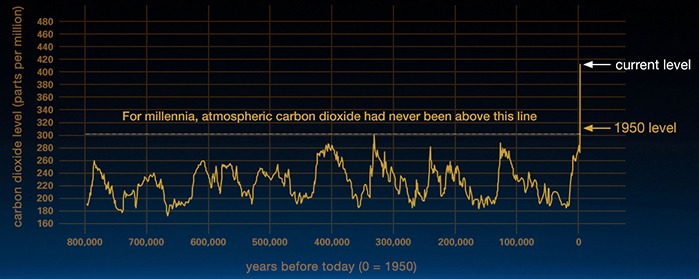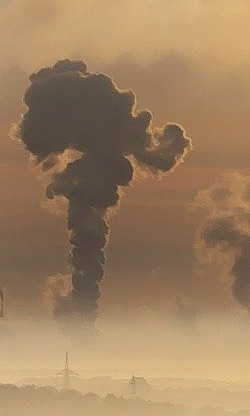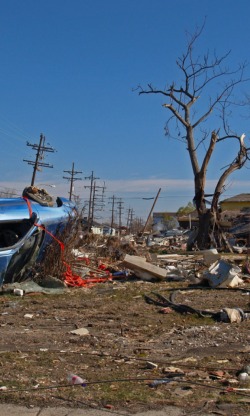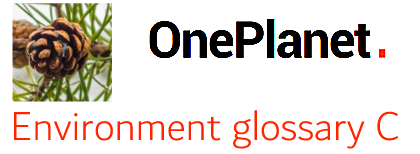OnePlanet is for people who speak English as a second or third language
A B C D E F G H I J K L M N O P Q R S T U V W X Y Z CLICK for list of all the words
C is for: |
: |
carbon dioxideWhen a plant grows, where does it get its solid matter from? What is a flower, a leaf, a bush or a tree made of? Does a plant suck its solid matter up from water and from the earth? No - it takes it from the air. Every flower, every leaf, every blade of grass, every tree, was just gas before the plant made it solid. A lot of it was carbon dioxide. Dry wood is about 50% carbon. (A living tree is only about 16% carbon because it's 60% water.) Carbon dioxide or CO2 is different from most of the other gases in the atmosphere. Nitrogen, oxygen and argon let solar energy in and out. Carbon dioxide and methane let the sun's heat in - but not out. They let short-wave solar energy in through the atmosphere, but they stop long-wave heat radiation from the Earth getting out again. Like a greenhouse. Which is why they're called "greenhouse gases". Carbon dioxide is a very small part of the atmosphere, but it's a very big factor in all kinds of climate change. There are other factors from time to time (solar activity, volcanic eruptions, big meteor strikes) but carbon dioxide has been the big one since humans arrived on the planet. Even before industrialisation, we increased the amount of carbon dioxide in the air by cutting down forests. When a tree burns or decays, the carbon goes back into the air as carbon dioxide. CO2 really is only a tiny part of the atmosphere; usually about 0.03%, and still only 0.04% at present. It's because it exists in such tiny quantities that human activities make a big difference to the amount. With CO2 there's a big difference between 0.03% and 0.04%. We put extra CO2 into the air by burning coal and oil, and by cutting down forests. (Note 1: The connection between coal, oil and forests is that coal was once tropical forests of giant, tree-sized ferns, mosses and horsetails; and oil was once algae and phytoplankton. Because they are dead, and compressed into a new form, we call them "fossil fuels". Note 2: We have also changed the atmosphere by having lots of cows. Cows produce some carbon dioxide and quite a lot of methane or CH4. Methane is also a greenhouse gas. In fact, it's even worse than carbon dioxide. It is produced by animals and plants, and it is released accidentally by the energy industry, in huge quantities, during coal and oil production. However, this article is about carbon dioxide). Coal and oil are the biggest source of extra CO2 (and extra CH4). Both industry and intensive agriculture depend on burning coal and oil, for power and for fertiliser. Since the beginning of the Industrial Revolution, we have put 450 billion tonnes of carbon dioxide into the atmosphere (and a lot of methane). For most of the last 3 million years, carbon dioxide levels were between 200 and 280 ppm. The line on the graph goes up (volcanoes and warm periods), then the line goes down (cool periods). Since the start of the Industrial Age, the line on the graph has been going straight up. Graph by NASA, 2020:  In 2013 the amount of CO2 in the atmosphere went past 400 ppm. It has since gone past 410 ppm, and that line is rising faster every year. China is by far the biggest emitter of CO2 at present. I met a Chinese girl in England a couple of years ago. She had just arrived to start a university course. She was walking by the sea for the first time, and she could not stop saying, "The air here is so clean! So clean!" She lived in Yutian, about 120 km east of Beijing. She was afraid I worked for the British or Chinese intelligence services. You can't see this extra carbon dioxide or methane, or smell them, but they do two things: First, they make the planet slightly warmer because of the greenhouse effect. This is enough to change climates all over the planet, and it's starting to cause extreme weather. See Climate Change. Second, CO2 combines with water to form weak carbonic acid. This dissolves the shells of sea creatures, and coral reefs. Shellfish are a very important part of the oceanic system. If we break the oceans, that's a problem for the planet, not just for a pretty reef or a few fish. Ruhr valley image by Foto-Rabe on Pixabay. |
 |
climate changeDeath and climate change are both natural, but some deaths and some climate change are caused by human activity. Human activity (cars, industry, cows) puts extra carbon dioxide and methane into the atmosphere. This causes global warming. Global warming causes climate change and extreme weather. Surface temperatures on the planet have increased by about 1°C since the start of the industrial period. We can see this in many places, such as the north of Canada and Siberia where the permafrost is starting to melt. "Permafrost" means "permanently frozen". The permafrost contains mammoths, diseases and other interesting things, but it also contains a lot of dead plants. Really a lot. And the dead plants contain a lot of carbon and methane. And it's starting to melt. Global warming of 2°C is likely to cause catastrophic and irreversible climate change. Global warming is happening; climate change is already happening. The only doubt is about what's causing the global warming. Climate scientists have no real doubts about that. Oil companies and multi-billionaires pay economists, statisticians and dishonest lawyers to find doubts and publicise them. There are always uncertainties with a complex system like the human body, but that does not stop us doing the intelligent thing about asbestos and cancer. With a huge, complex system like a planetary climate, there will always be uncertainties, but we can still do the intelligent thing about global warming and climate change. Businesses certainly don't wait for absolute certainty before they make crucial decisions - except for the crucial decision to help stop climate change. There, they demand absolute certainty. "Global warming" does not mean that everywhere gets slightly warmer. Some parts of planet Earth will get slightly warmer, as Siberia is doing. Some parts will get so hot and dry that they burn like Australia in January 2020. Some parts will be drowned by extra rain or rising sea levels. Some will no longer have enough water for farming, and some will freeze. If we continue to put large quantities of carbon dioxide and methane into the atmosphere, billions of people will have to migrate or die. How can global warming make parts of the planet colder? By changing the Atlantic Meridional Overturning Circulation (AMOC). The AMOC is part of the thermohaline circulation (THC). The THC is a system of ocean currents, powered by heat and salt density, that moves heat around the planet. The AMOC does this in the Atlantic, from Iceland all the way down to the Antarctic ice. The Gulf Stream is a major part of the AMOC. It carries tropical heat from the Caribbean into the North Atlantic. This makes northern Europe much warmer. Without the most northerly part of the Gulf Stream (the North Atlantic Current or NAC), northern Europe and parts of north America would be covered in ice and snow for half the year. This scenario is called "NAC shutdown". You may have seen it in the adventure film "The Day After Tomorrow". Parts of Britain are further north than Moscow; they're as far north as Hudson Bay in Canada, where the sea freezes every year from December to June. The indirect effects of the Gulf Stream are the only thing that stops the sea around Britain, the Netherlands and Scandinavia from freezing. No more NAC would mean no more farming in northern Europe, Canada and much of America. Shutdown is when a system stops, slowdown is when it works more slowly or weakly. NAC shutdown is a real possibility. The AMOC has already weakened in the last 20 years. Researchers at Utrecht University predict a 15% chance of NAC shutdown in the next hundred years. Both NAC shutdown and slowdown have already happened during human times. About 12,800 years ago it took only two or three years for northern Europe - and large parts of north America - to get covered in snow and ice. Everybody in northern Europe either moved south or died. This very cold period is called the "Younger Dryas" or the "Big Freeze", and it lasted more than a thousand years. It is believed to have been caused by NAC shutdown. NAC slowdown, caused by rising temperatures in the northern hemisphere, is believed to have caused the "Little Ice Age". This hit north-west Europe and parts of north America in about 1430, and lasted nearly 500 years. The Norse population of Greenland all left or died; the population of Iceland dropped by 50%; famines killed 30% of people in Finland, 20% in Estonia and 10% in Norway, Sweden and France, with malnutrition across much of Europe and north America. Wild and domestic animals died; there was disease, violence and unemployment; extreme weather caused massive flooding and coastal erosion in Denmark and Germany; there were repeated snowstorms in Portugal and other parts of southern Europe. Clothing styles changed and became warmer; more efficient fireplaces and chimneys were installed in homes and public buildings; there was a rise in religious fundamentalism. We have the power to cause a climate disaster, by releasing huge quantities of carbon dioxide and methane into the atmosphere, and we are doing exactly that, faster and faster. This has already affected the climate and, when it reaches a certain point, major climate change will just start rolling on its own, and it will roll right over us. That's what scientists mean by a "tipping point". We have the power to break the climate, but we don't have the power to fix it when it's broken. Climate change has been quietly minding its own business for thousands of years, but we're waking it up. We don't know exactly what it will do, but we know it won't be good. Image by Gabe Raggio on Pixabay |
 |
...New words every week; CLICK HERE for a full list |
 |
* |
* |
A B C D E F G H I J K L M N O P Q R S T U V W X Y Z CLICK for list of all the words
